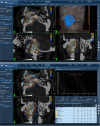Treatment for paraganglioma with stereotactic radiotherapy
- PMID: 38899289
- PMCID: PMC11185345
- DOI: 10.12998/wjcc.v12.i16.2729
Treatment for paraganglioma with stereotactic radiotherapy
Abstract
Background: Paragangliomas (PG) are rare neoplasms of neuroendocrine origin that tend to be highly vascularized, slow-growing, and usually sporadic. To date, common treatment options are surgical resection (SR), with or without radiation therapy (RT), and a watch-and-wait approach.
Aim: To evaluate the local control and effectiveness of exclusive fractionated stereotactic RT (FSRT) treatment in unresectable PG (uPG).
Methods: We retrospectively evaluated patients with uPG (medically inoperable or refused SR) treated with FSRT with a Cyberknife System (Accuray Incorporated, Sunnyvale, California). Toxicity and initial efficacy were evaluated.
Results: From May 2009 to January 2023, 6 patients with a median age of 68 (range 20-84) were treated with FSRT. The median delivered dose was 21 Gy (range 20-30 Gy) at a median isodose line of 75.5% (range 70%-76%) in 4 fractions (range 3-5 fractions). The median volume was 13.6 mL (range 12.4-65.24 mL). The median cumulative biological effective dose and equivalent dose in 2-Gy fractions were 70 Gy and 37.10 Gy respectively. Site of origin involved were the timpa-nojugular glomus (4/6), temporal bone, and cervical spine. In 1 of the 6 patients, the follow-up was insufficient; 5 of 6 patients showed a 5-year overall survival and 5-year progression-free survival of 100%. We observed negligible toxicities during and after RT. The majority of patients showed stable symptoms during follow-up. Only 1 patient developed spine metastases.
Conclusion: Our preliminary results on this small cohort of patients suggest that FSRT could be an effective and safe alternative to SR.
Keywords: Cyberknife; Fractionated stereotactic radiation therapy; Metastasis; Neurosurgery; Unresectable paraganglioma.
©The Author(s) 2024. Published by Baishideng Publishing Group Inc. All rights reserved.
Conflict of interest statement
Conflict-of-interest statement: The authors declare no conflict of interest.
Figures
References
-
- Pellitteri PK, Rinaldo A, Myssiorek D, Gary Jackson C, Bradley PJ, Devaney KO, Shaha AR, Netterville JL, Manni JJ, Ferlito A. Paragangliomas of the head and neck. Oral Oncol. 2004;40:563–575. - PubMed
-
- Offergeld C, Brase C, Yaremchuk S, Mader I, Rischke HC, Gläsker S, Schmid KW, Wiech T, Preuss SF, Suárez C, Kopeć T, Patocs A, Wohllk N, Malekpour M, Boedeker CC, Neumann HP. Head and neck paragangliomas: clinical and molecular genetic classification. Clinics (Sao Paulo) 2012;67 Suppl 1:19–28. - PMC - PubMed
-
- Boedeker CC, Ridder GJ, Neumann HP, Maier W, Schipper J. [Diagnosis and management of cervical paragangliomas: the Freiburg experience] Laryngorhinootologie. 2004;83:585–592. - PubMed
LinkOut - more resources
Full Text Sources
Research Materials


